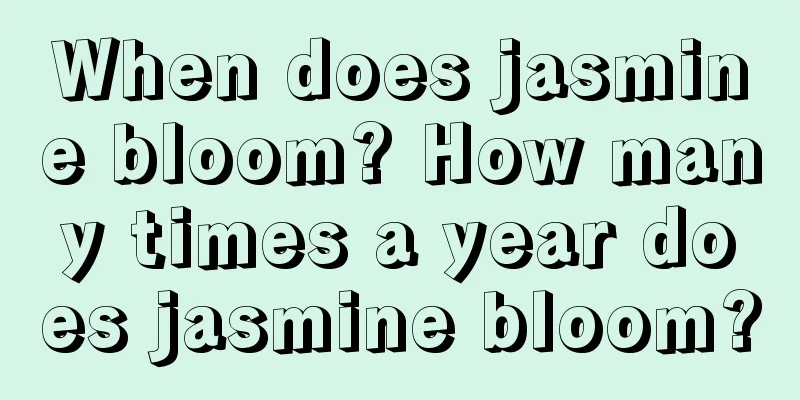When does jasmine bloom? How many times a year does jasmine bloom?

1. When does jasmine bloom?Jasmine usually blooms from May to August every year. If properly cared for, the flowering period can be extended to October or November. The flowers are borne in terminal cymes, with three flowers on a single inflorescence, but sometimes they are single and sometimes there are up to five flowers. The flowers are pure white and elegant, with a strong fragrance. 2. How many times does jasmine bloom in a year?If grown properly, it can bloom three times a year. The first flowering is from May to August, the second flowering is from August to September, and the third flowering is from September to early October, and the number is less than before. First flowering: It blooms in early June and is commonly known as "moldy flower". In early June, jasmine will begin to bloom early. At this time, the flowers will be smaller and fewer, and need to be picked in time, otherwise they will consume nutrients for the winter and affect the quality and quantity of subsequent flowering. Second flowering: It blooms in late August, commonly known as "Fuhua". At this time, it is necessary to increase the frequency and amount of fertilization for the plants in time. In order to make it bloom better, you can spray calcium phosphate solution on the leaves. The third flowering period: It blooms from early September to mid-October, commonly known as "autumn flowers". At this time, the weather turns cooler, so stop fertilizing and reduce watering, otherwise it will affect the number of flower buds. After the flowering is over, keep the soil in the pot moist so that the plant can survive the winter smoothly. 3. Jasmine maintenance method1. Potting soil: It is best to choose soil rich in organic matter, with good water retention, air permeability and permeability for growing jasmine. For example, you can use a mixture of 5 parts leaf mold, 4 parts sandy loam, and 1 part cake fertilizer as the culture soil. 2. Fertilization: During the growing period, you can apply more organic fertilizers and phosphorus and potassium fertilizers once a month. During the bud formation and flowering period, apply thin fertilizer once every 7 days. Stop fertilizing after late autumn. 3. Watering: Water in appropriate amounts. Follow the principle of not watering unless the soil is dry, and watering thoroughly when you do. 4. Temperature: Jasmine is afraid of cold, so it is best kept in a sunny place indoors. The indoor temperature should not be lower than 8 degrees. When the temperature is too low, you can cover it with plastic bags to prevent wind and frost. |
<<: Watermelon planting technology, when to plant watermelon
>>: What are the characteristics of creeper? Complete picture of creeper
Recommend
Do spider plants need watering every day?
Do you water spider plants every day? Chlorophytu...
What kind of soil does camellia like? How to prepare the soil for camellia?
1. What kind of soil do you like? Camellia likes ...
Can I grow plum blossoms at home?
Can I grow plum blossoms at home? You can plant p...
The flower language and meaning of Cyclamen
The Flower Language of Cyclamen Flower language 1...
Does Forsythia prefer shade or sun?
Does Forsythia prefer shade or sun? Forsythia is ...
How to solve the problem of sows having low milk supply?
Some sows do not produce milk or produce little m...
What is coconut bran?
Coconut peat introduction Coconut bran refers to ...
Environmental conditions and characteristics of watermelon growth
Environmental conditions and requirements for wat...
How to Prune Lucky Bamboo
Why pruning is necessary Lucky bamboo has a stron...
Breeding methods and precautions of bear's paw
1. Soil To grow bear's paw, you need fertile ...
Oil peony planting method, what is the prospect
1. Planting method 1. Site selection: When planti...
Where is the best place to grow bananas?
Banana growing area Generally, bananas grow in a ...
How to plant California poppy seeds
Sowing time Generally speaking, it is suitable to...
Diseases and Pests of Tuberose and Their Control
Diseases and their control of tuberose Fusarium w...
The growing environment and local conditions of bean sprouts
The growing environment and conditions of bean sp...









